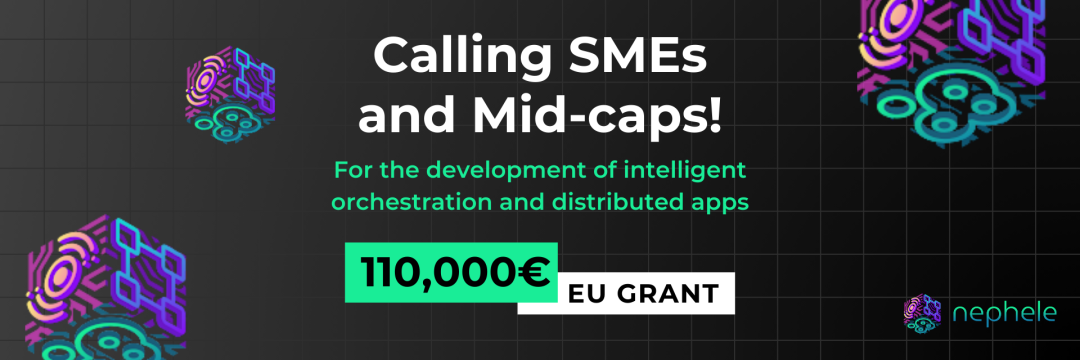In order to achieve the project’s goals, NEPHELE distributed up to €1,49M among SMEs/Mid-caps that were selected through 2 Open Calls.
2nd Open Call: Use Cases development and NEPHELE approach validation - targeting up to 8 SMEs/Mid-caps to develop use cases and validate the NEPHELE architectural approach & synergetic meta-orchestration framework.
- Open Date
- 19 August 2024 at 9:00 Brussels Time
- Close Date
- 20 October 2024 at 9:00 Brussels Time

- Type of actions funded
Validation of the proposed architectural approach of the NEPHELE platform and synergetic meta-orchestration framework implementation, based on the development of intelligent orchestration mechanisms and a set of distributed applications (incl. VOs, cVOs). Proposals must address one of the two types of projects listed below:
- 1st project type: Development and deployment of a distributed application for the computing continuum
- 2nd project type: Development, integration and evaluation of an intelligent orchestration mechanism for the NEPHELE Synergetic Meta-Orchestrator.
- Average Value
- EUR 110K
- Eligible organisations
- Industrial SMEs/Mid-caps.
- Average duration
- 6 months for the implementation
- Number of grants awarded
- 8
- Open Call announcement on the EU Funding & Tenders portal
- EU Funding & Tenders Portal | EU Funding & Tenders Portal (europa.eu)
- More info, Guide for Applicants and FAQ
- NEPHELE 2nd open call
- Contact Helpdesk
- Contact helpdesk
- join our helpdesk at Discord
- NEPHELE 2nd Open Call - open source repository
- Repository
List of winners
METACUS.AI is the meta-orchestrated European sensor grid for climate and environment monitoring. The aim of METACUS.AI is to transform the existent DEUS air pollution and emission monitoring system to a more flexible, scalable system. DEUS is Europe's largest climate and environmental measurement grid, which uses modular sensors to measure traffic, CO2, PM2.5, PM10, VOC (Volatile Organic Compounds), weather, and more. DEUS offers real-time environment data visualization and analysis for public and private sectors.
SWARMEON
Link LinkDistributed Control for Collaborative Autonomous Mobile Robots Swarms
Mantelbi S. L.
Autonomous Mobile Robots (AMRs) are fast and cost-effective solutions for logistics, but they need more flexibility in handling heterogeneous loads and individual or global disturbances. SWARMEON enhances the cooperative capabilities of the swarm. The project developed a VO as a virtual counterpart of each AMR and a cVO for joining the information of the AMR swarm.
SWIM developed a distributed infrastructure for water plant monitoring, maintenance and leaks detection by using IoT sensors, edge devices, and analytics and AI-based algorithms.
VOGrid Real digitalised transformers using Linc’s scalable IoT hardware and real-time analytics to provide predictive maintenance and enhanced grid management. The system tracks electrical, thermal and vibrational data using NEPHELE’s Virtual Object (VO) and Composite Virtual Object (cVO) framework to create digital twins of transformers, optimising performance and preventing failures.
H3NI integrates Hop3 orchestration platform with NEPHELE and enables dynamic scaling, compute offloading, live migration and AI/ML workflow management. It addresses industries such as healthcare, smart cities, logistics and energy.
Headlight is an AI-enabled and context-aware orchestration mechanism to support NEPHELE. The mechanism get a holistic view of the system thanks to a graph-based composite architecture.
DROP developed a distributed resource offloading mechanism leveraging the vAccel framework for ESP32-based IoT devices. It enables real-time processing capabilities for resource-constrained devices while reducing latency and improving system efficiency. It fosters innovation in logistics, smart home and industrial automation.
AIoTGuard is a solution for safety logistics environments by preventing accidents between pedestrians and forklifts. The system integrates AI-powered computer vision models with low-latency video analytics and centralized event management to detect pedestrians in real-time and trigger dynamic alerts by projecting warning signs on the ground.
More Info, Github code, Demo